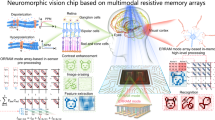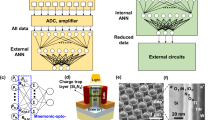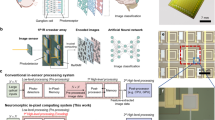Abstract
Neuromorphic visual systems have considerable potential to emulate basic functions of the human visual system even beyond the visible light region. However, the complex circuitry of artificial visual systems based on conventional image sensors, memory and processing units presents serious challenges in terms of device integration and power consumption. Here we show simple two-terminal optoelectronic resistive random access memory (ORRAM) synaptic devices for an efficient neuromorphic visual system that exhibit non-volatile optical resistive switching and light-tunable synaptic behaviours. The ORRAM arrays enable image sensing and memory functions as well as neuromorphic visual pre-processing with an improved processing efficiency and image recognition rate in the subsequent processing tasks. The proof-of-concept device provides the potential to simplify the circuitry of a neuromorphic visual system and contribute to the development of applications in edge computing and the internet of things.
This is a preview of subscription content, access via your institution
Access options
Access Nature and 54 other Nature Portfolio journals
Get Nature+, our best-value online-access subscription
$29.99 / 30 days
cancel any time
Subscribe to this journal
Receive 12 print issues and online access
$259.00 per year
only $21.58 per issue
Buy this article
- Purchase on Springer Link
- Instant access to full article PDF
Prices may be subject to local taxes which are calculated during checkout




Similar content being viewed by others
Data availability
The data that support the plots within these paper and other findings of this study are available from the corresponding author upon reasonable request.
Code availability
The simulation codes used for this study are available from the corresponding author upon reasonable request.
References
Shepherd, R. K., Shivdasani, M. N., Nayagam, D. A., Williams, C. E. & Blamey, P. J. Visual prostheses for the blind. Trends Biotechnol. 31, 562–571 (2013).
Kolb, H. How the retina works: much of the construction of an image takes place in the retina itself through the use of specialized neural circuits. Am. Sci. 91, 28–35 (2003).
Brady, T. F., Konkle, T., Alvarez, G. A. & Oliva, A. Visual long-term memory has a massive storage capacity for object details. Proc. Natl Acad. Sci. USA 105, 14325–14329 (2008).
Kim, Y. et al. A bioinspired flexible organic artificial afferent nerve. Science 360, 998–1003 (2018).
Lee, G. J., Choi, C., Kim, D. H. & Song, Y. M. Bioinspired artificial eyes: optic components, digital cameras, and visual prostheses. Adv. Funct. Mater. 28, 1705202 (2018).
Song, Y. M. et al. Digital cameras with designs inspired by the arthropod eye. Nature 497, 95–99 (2013).
Jeong, K.-H., Kim, J. & Lee, L. P. Biologically inspired artificial compound eyes. Science 312, 557–561 (2006).
Ko, H. C. et al. A hemispherical electronic eye camera based on compressible silicon optoelectronics. Nature 454, 748–753 (2008).
Zhang, L. et al. Self-suspended nanomesh scaffold for ultrafast flexible photodetectors based on organic semiconducting crystals. Adv. Mater. 30, 1801181 (2018).
Choi, C. et al. Human eye-inspired soft optoelectronic device using high-density MoS2–graphene curved image sensor array. Nat. Commun. 8, 1664 (2017).
Lee, W. et al. High-resolution spin-on‐patterning of perovskite thin films for a multiplexed image sensor array. Adv. Mater. 29, 1702902 (2017).
Du, C. et al. Reservoir computing using dynamic memristors for temporal information processing. Nat. Commun. 8, 2204 (2017).
Wu, C., Kim, T. W., Choi, H. Y., Strukov, D. B. & Yang, J. J. Flexible three-dimensional artificial synapse networks with correlated learning and trainable memory capability. Nat. Commun. 8, 752 (2017).
Yao, P. et al. Face classification using electronic synapses. Nat. Commun. 8, 15199 (2017).
Yu, S. et al. A low energy oxide‐based electronic synaptic device for neuromorphic visual systems with tolerance to device variation. Adv. Mater. 25, 1774–1779 (2013).
Leydecker, T. et al. Flexible non-volatile optical memory thin-film transistor device with over 256 distinct levels based on an organic bicomponent blend. Nat. Nanotechnol. 11, 769–775 (2016).
Zhou, F. et al. Low-voltage, optoelectronic CH3NH3PbI3−xClx memory with integrated sensing and logic operations. Adv. Funct. Mater. 28, 1800080 (2018).
Tan, H. et al. An optoelectronic resistive switching memory with integrated demodulating and arithmetic functions. Adv. Mater. 27, 2797–2803 (2015).
Cheng, Z., Ríos, C., Pernice, W. H., Wright, C. D. & Bhaskaran, H. On-chip photonic synapse. Sci. Adv. 3, e1700160 (2017).
Zhu, D. et al. Resistive random access memory and its applications in storage and nonvolatile logic. J. Semicond. 38, 071002 (2017).
Yang, J. J. et al. Memristive switching mechanism for metal/oxide/metal nanodevices. Nat. Nanotechnol. 3, 429–433 (2008).
Deb, S. & Chopoorian, J. Optical properties and color-center formation in thin films of molybdenum trioxide. J. Appl. Phys. 37, 4818–4825 (1966).
Colton, R. J., Guzman, A. M. & Rabalais, J. W. Photochromism and electrochromism in amorphous transition metal oxide films. Acc. Chem. Res. 11, 170–176 (1978).
Yao, J., Loo, B., Hashimoto, K. & Fujishima, A. Photochromic and electrochromic behavior of electrodeposited MoO3 thin films. J. Electroanal. Chem. 290, 263–267 (1990).
Wang, S., Fan, W., Liu, Z., Yu, A. & Jiang, X. Advances on tungsten oxide based photochromic materials: strategies to improve their photochromic properties. J. Mater. Chem. C 6, 191–212 (2018).
Balendhran, S. et al. Two-dimensional molybdenum trioxide and dichalcogenides. Adv. Funct. Mater. 23, 3952–3970 (2013).
Lei, Y.-H. & Chen, Z.-X. DFT+U study of properties of MoO3 and hydrogen adsorption on MoO3(010). J. Mater. Chem. C. 116, 25757–25764 (2012).
Yao, J., Yang, Y. & Loo, B. Enhancement of photochromism and electrochromism in MoO3/Au and MoO3/Pt thin films. J. Phys. Chem. B 102, 1856–1860 (1998).
Zhang, Y., Lee, S.-H., Mascarenhas, A. & Deb, S. An UV photochromic memory effect in proton-based WO3 electrochromic devices. Appl. Phys. Lett. 93, 203508 (2008).
Tsuruoka, T. et al. Effects of moisture on the switching characteristics of oxide-based, gapless-type atomic switches. Adv. Funct. Mater. 22, 70–77 (2012).
Kumar, A. & Kumar, A. Light-induced metastable defects in a-Se90X10 (X = Sb, In and Ag) thin films. Phase Transit. 88, 939–949 (2015).
Park, H., Liu, J. & Wagner, S. Saturation of the light‐induced defect density in hydrogenated amorphous silicon. Appl. Phys. Lett. 55, 2658–2660 (1989).
Street, R. & Davies, D. Kinetics of light induced defect creation in organic solar cells. Appl. Phys. Lett. 102, 043305 (2013).
Lei, S. et al. Optoelectronic memory using two-dimensional materials. Nano Lett. 15, 259–265 (2014).
Acknowledgements
This work was supported by the Research Grants Council of Hong Kong (PolyU 152053/18E), the Hong Kong Polytechnic University (G-YBPS, 1-ZVGH, 1-ZE25 and G-SB79) and the National Natural Science Foundation of China (61851402 and 61421005). F.Z. thanks Y. Liu, Y. Zhang and M. Wang for helpful discussions, S. H. Cheung and S. K. So for the photothermal deflection spectroscopy test and J. Zhang for the ultraviolet photoelectron spectroscopy test.
Author information
Authors and Affiliations
Contributions
Y.C. and F.Z. conceived and designed the project. Y.C. supervised the project. F.Z., T.H.C., J.W. and Z.L. performed the experiments, including both fabrication and characterization. Z.Z., F.Z., J.C., S.Y. and J.K. performed the simulations. J.C. performed the density functional theory calculations. F.Z., N.Z., Y.C., S.Y., J.K. and H.-S.P.W. analysed the data. F.Z. and Y.C. co-wrote the paper. All the authors discussed the results and commented on the manuscript.
Corresponding author
Additional information
Peer review information: Nature Nanotechnology thanks Dae-Hyeong Kim and the other, anonymous, reviewer(s) for their contribution to the peer review of this work.
Publisher’s note: Springer Nature remains neutral with regard to jurisdictional claims in published maps and institutional affiliations.
Supplementary information
Supplementary materials: Optoelectronic RRAM for Neuromorphic Vision Sensors
Supplementary information.
Rights and permissions
About this article
Cite this article
Zhou, F., Zhou, Z., Chen, J. et al. Optoelectronic resistive random access memory for neuromorphic vision sensors. Nat. Nanotechnol. 14, 776–782 (2019). https://doi.org/10.1038/s41565-019-0501-3
Received:
Accepted:
Published:
Issue Date:
DOI: https://doi.org/10.1038/s41565-019-0501-3
This article is cited by
-
On-chip optoelectronic logic gates operating in the telecom band
Nature Photonics (2024)
-
High-order sensory processing nanocircuit based on coupled VO2 oscillators
Nature Communications (2024)
-
Non-volatile rippled-assisted optoelectronic array for all-day motion detection and recognition
Nature Communications (2024)
-
Nonvolatile and reconfigurable two-terminal electro-optic duplex memristor based on III-nitride semiconductors
Light: Science & Applications (2024)
-
High performance artificial visual perception and recognition with a plasmon-enhanced 2D material neural network
Nature Communications (2024)



